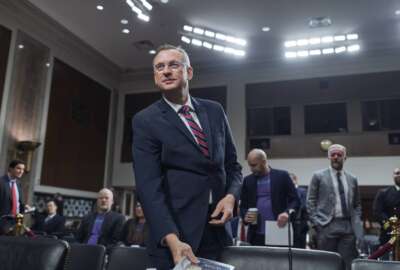Federal effort that reduced coal mining dangers
Few occupations match the many dangers of coal mining. Even to this day, miners experience the dangers of mine collapses.
Few occupations match the many dangers of coal mining. Even to this day, miners experience the dangers of mine collapses. The Federal Drive with Tom Temin next guest is a former coal miner and has devoted a federal career to improving mine safety. His platforms: The Bureau of Mines and, more recently, the Mine Safety and Health Administration, which is part of the Labor Department. Christopher Mark is now a finalist in this year’s Service to America Medals program.
Interview Transcript:
Tom Temin
And we should point out I referred to you as Dr. Mark, because you got an doctorate degree in mining. Fair to say?Christopher Mark
That’s correct. Yes. In mining engineering, and geomechanics. My specialty is strata control underground, coal mines in particular.Tom Temin
All right. And just briefly, you were a coal miner when? And what was it like?Christopher Mark
I got a job in the coal mines in southern West Virginia, in Boone County, West Virginia back in 1976. And this was really at the height of the energy crisis. And so there was a lot of expansion going on in the industry, then. It was also a time of major transition in safety in the mines, which I was not really aware of, I just turned 20 years old. But a major landmark legislation, the 1969 Health and Safety Act, had just gone into effect a few years before, and it was still quite a bit of change going on in the industry.Tom Temin
All right. And at some point, you decided, well, maybe mining is not the job you’d like to have for the next 40 years. So how did you make the transition to mining engineering and then to the federal government?Christopher Mark
Well, I was absolutely fascinated with coal mining when I worked underground. So that’s why I decided to study Mining Engineering. And in particular, the field that I later specialized in, the mine I worked at, we really had some pretty poor roof conditions. So there were roof collapses on a regular basis, nobody that I worked with was killed in any of those, but it certainly intrigued me as a career. At that time, I really wasn’t thinking that far ahead. But ultimately, that became my kind of career goal to learn more about strata control, ground control, and then to try to do something about it.Tom Temin
Yeah, that idea of strata control is what causes or lack of strata control. People think that the roof collapses in mines, or from the weight above, and that just gets too much in the roof comes down. I guess your discovery is that there are lateral movements that can cause vertical movements. Is that basically what your chief finding has been.Christopher Mark
There’s a number of different aspects to it. That’s one aspect. I hope this isn’t getting too technical. But really, there’s kind of two classes of problems that we deal with. The first one is that you always do have the huge weight of the rock that’s above you. Our coal mines are 500, 1,000, sometimes 2,000 feet deep. And so something has to be there to hold up that 2,000 feet of rock, or it’s just going to smash any workings that you have. And so what you do is you have to leave coal in place strategically in large pillars, maybe 100 feet by 100 feet square. So one big part of my field is sizing these pillars so that you can control the great weight of the mountain above you. So this is what we call global stability. But then you also have local stability, which is dealing with the immediate roof right above the tunnel, the tunnel is typically about 20 feet wide. So it’s that rock directly above you, maybe everything from a small piece of rock, all the way up to maybe 5, 10, 20 feet of rock at the most. But making sure that doesn’t come down when people are working underneath it. And it’s particularly for that local stability problem that the horizontal forces become important. And you’re right, that was a discovery that I made several decades ago. I made the connection, I guess, between the horizontal forces that we see underground, and the plate tectonics that has really transformed the whole earth. All our mountain building and faulting and so on is also related to plate tectonics. And I just kind of connected those two fields and was able to use that knowledge to design better roof support systems for coal mines.Tom Temin
We’re speaking with Christopher Mark, he’s a principal strata control specialist at the Mine Safety and Health Administration, and a finalist in this year’s Service to America Medals program. And more than just discovered it, you codified it in tables and in software to help the industry design mines and mines supports better. Tell us more about that.Christopher Mark
That was one of the things from my mining experience. And then my kind of close relationships with people actually working in the industry. I kind of realized, and again, this is decades ago, that to put ones research findings in the form of say a peer reviewed publication or even a textbook, that it was going to be very difficult for people to use those things for professional people. We’re not talking about the coal miners underground here, but the professional people who design the mines, but even they were not going to go straight from some kind of a text to a mine design. But on the other hand, if you could take that knowledge and put it into a computer program that was easy to use, then that would have a lot more impact that people would be much more likely to use it. So that’s been kind of one of the real focal points of my work to try to take the research that I do, and then boil it down into a form that’s easy to use, and then put it into a computer program that is easily accessed by the busy mining professionals that don’t do strata control full time and have to fit that into the rest of the work that they do.Tom Temin
And your citation mentioned that you have some 160 published peer reviewed papers. So it sounds as if you didn’t discover something 40 years ago, and that’s it. It sounds like this is an ongoing refinement and discovery process for you.Christopher Mark
Absolutely. As you mentioned, when I finished my doctorate, I started working for the US Bureau of Mines, which was an agency that went back to 1910. And the Bureau of Mines was actually closed down back in 1995. But the safety research function, it was a research organization. And the research function was folded into the National Institute for Occupational Safety and Health (NIOSH). So we became the mining arm of NIOSH. So I continued to do research there up until 2010. So during that time, I was able to address a whole range of issues related to strata control. And in each case, tried to kind of move the boundaries of what the best practices were based on the new knowledge I developed, and then get those concepts transferred out to the mining professionals. And then in 2010, I actually transitioned, as you also said, over to the Mine Safety and Health Administration. So this is the safety enforcement arm of the federal government, which again, goes back to that 1969 Health and Safety Act. So my role there is as kind of the chief technical advisor when it comes to strata control issues.Tom Temin
And you and I are roughly the same age, within a year of one another, based on the arithmetic I did that you described. And does your mind, as mine sometimes does, wonder back when you’re doing your work to that initial job you had in the mine, digging the coal?Christopher Mark
Absolutely. And I’ve actually had the luxury in the last few years of writing a couple of papers that directly address that history. In fact, I just had one published that I kind of dug back into industry literature, the trade magazines and so forth of that era, the 60s and 70s going forward and also evaluating the reports of fatal accidents, to try to see exactly what were the things that killed coal miners in those days. We know it was roof falls, but what were the individual attributes? And then how have we addressed them over the years, because when I started working in the mines, on average, every week, a coal miner was killed in a roof fall underground. And in 2016, we had the first year where we had zero roof fall fatalities. So even though the workforce is a lot smaller, still, that’s a tremendous improvement. So I was able to look back and kind of pinpoint exactly which of the innovations that came in during that time really made a difference.
Copyright © 2025 Federal News Network. All rights reserved. This website is not intended for users located within the European Economic Area.
Tom Temin is host of the Federal Drive and has been providing insight on federal technology and management issues for more than 30 years.
Follow @tteminWFED






